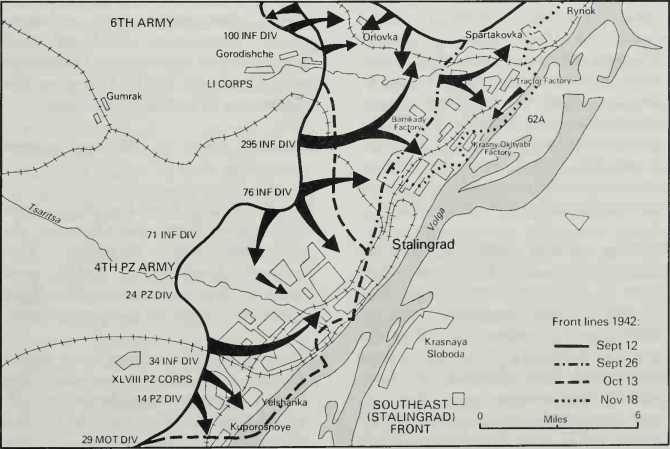German assault on Stalingrad, 1942: led to disaster, January 1943

Unpreparedness for the eventual invasion. He exercised a close personal control of the conduct of the war and although his singlemindedness often reaped rewards, his interference with specific campaigns and battles was frequently counter-productive. Having begun the war relying upon generats who had been his associates during the Civil War, he had the sense to accept the counsels of younger, more versatile commanders such as Zhukov and Vasilevsky. Stalin also showed himself to be an astute and guileful negotiator at the many Allied conferences and succeeded in carving out of the postwar settlements a series of communist satellite states in eastern Europe. MS.
Stalingrad, Battle of (1942-43). In late June 1942, German Army Group South (von Bock) - from July 9 designated Army Group B (von Weichs) - began an offensive towards Stalingrad (Volgograd). Fourth Panzer Army (Hoth) reached the Don river at Voronezh, quelling opposition by the Russian Voronezh Front (Vatutin) on June
28-July 6, but was then briefly diverted to the Caucasus offensive. This slowed the progress of German Sixth Army (von Paulus), whose Don bridgehead around Kalach was only secured, after heavy fighting, on August 21. Now advancing rapidly, Paulus’s XIV Panzer Corps reached the Volga river north of Stalingrad on August 23, while Fourth Panzer Army returned to strike at the city from the southwest. Rather than complete the encirclement by flanking moves across the Volga to north and south. Hitler, concerned with the symbolic value of the city that bore Stalin’s name as much as its strategic importance, ordered an all-out assault.
From September 12, when German troops reached the suburbs, Stalingrad’s defenders - Sixty-second Army (Chuikov), with limited reinforcement and artillery support from Southeast (Stalingrad) Front (Yeremenko) east of the Volga — fought a heroic house-to-house battle, aided, ironically, by massive German bombardments that had reduced much of the city to rubble, providing excellent defensive positions. In Octo-ber-November the Russian perimeter on the Volga’s west bank was reduced to no more than 1,500yd (1,370m) depth in some places — but the determined, defence had allowed Zhukov time to prepare a devastating counterattack. On November 19-20, Southwest Front (Vatutin) and Don Front (Rokossovsky) struck from the north and Yeremenko attacked from the southeast. The Russian pincers closed at Kalach, November 22-23, trapping Sixth Army and part of Fourth Panzer Army.
Paulus might have broken out, but Hitler, assured by Goring that the Luftwaffe could airlift 500 tons of supplies daily to Stalingrad (in
Fact, air supply averaged only c80 tons per day), ordered him to hold “lYrtre. ss Stalingrad” until relieved. Attempting to relieve Paulus, Army Group Don (von Manstein) attacked Yeremenko from the south, advancing to within 30 miles (48km) of Stalingrad, December 12-23, but then retreating before the combined counteroffensive of Vatutin and Yeremenko. Paulus, his troops exhausted by combat, starving, sick and frostbitten, still refused to surrender, and on January 8 1943 Rokossovsky attacked. By January 21 all airfields had fallen to the Russians; Paulus surrendered at his HQ on January 31; a few Germans resisted a little longer. Some
140,000 Germans died at Stalingrad, and of approximately 91,000 taken prisoner there it is estimated that only about 6,000 survived captivity. RO’N.
Stand-Off bomb. An older name for air to surface missiles that allow their aircraft to “stand off’ from their targets, thus avoiding terminal defences. A classic nuclear stand-off bomb, officially described as such, was the 192-mile (320km) range Blue Steel missile carried by British V-bombers from 1962 to 1975.
“S-Tank” {Stridsvagn 103) Swedish Main Battle Tank, introduced
1966. Dispensing with a conventional fully-traversing turret for its main armament (105mm gun), it carries it in the hull. The whole tank is traversed bodily on its tracks to shift target in azimuth and the suspension is adjusted for gun elevation. See also tanks.
Star Wars see strategic defense
INITIATIVE (SDl).
Stark, Adm Harold Raynsford (“Betty”) (1880-1972). US. Chief of Naval Operations, 1939; in conjunction with Gen Marshall, prepared US strategy for the coming war. After Pearl Harbor, he was criticized for failing to keep Adm Kimmel fully informed of Japanese movements and was in effect replaced as head of the navy by King. Commander of US Naval Forces in Europe in 1942; spent the rest of the war as the chief liaison between the American and British navies.




 World History
World History









